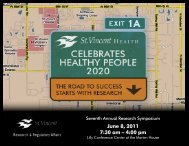Making Data Talk: A Workbook - National Cancer Institute
Making Data Talk: A Workbook - National Cancer Institute
Making Data Talk: A Workbook - National Cancer Institute
- No tags were found...
You also want an ePaper? Increase the reach of your titles
YUMPU automatically turns print PDFs into web optimized ePapers that Google loves.
CHAPTER SIX:Show What You Know: Communicating <strong>Data</strong>in Acute Public Health SituationsAcute public health situations are diverse in type, as well as the response and emotions they can cause. An infectiousdisease outbreak, for example, has the ability to cause fear, if not panic; floods can displace people and affecttheir economic livelihood; and the content of newly released screening guidelines may challenge widely heldbeliefs and even elicit anger. Acute public health situations are similar, however, with regard to how we shouldapproach communications about them. Outlined below are the defining characteristics and communicationrequirements of acute public health situations. This information is followed by an exercise that requires you toexamine how well an acute public health event was communicated to the public.After reading this chapter, you will be able to:➥ Identify the distinguishing characteristics of acute public health situations.➥ Evaluate an article (or other communication product) about an acute public health situation to identifyhow it may or may not be modified to effectively communicate data to the intended audience.Defining acute public health situationsAcute public health situations include infectious disease outbreaks, natural disasters, explosions or fires, possible adverseeffects from a drug or medical device, possible disease clusters, intentional adverse health events, actual or perceivedadverse effects of immunizations, psychological events, and unexpected (study) findings or influential reports. Theseand other acute public health situations can be characterized by one or more distinguishing characteristics:1) A discrete event or unexpected, unplanned, or extraordinary discovery.2) Actual or perceived serious or widespread health problem, or a new understanding or recommendationabout a health issue that will likely affect many.3) Potential to cause fear, anxiety, anger, or other emotions.4) Likely to receive news media attention.5) An expectation that public health professionals will quickly identify and resolve the problem.Various factors increase the chance that an event will become an acute public health situation and can stronglyinfluence communication. Those factors include:◆ Dreaded disease, condition, or catastrophic potential◆ Irreversibility of effects◆ Identifiable victims◆ Large magnitude (number of people affected)◆ Children involved or at risk◆ Uncontrollability28





